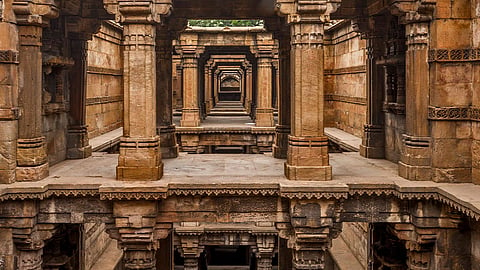Ahmedabad's Dada Harir Stepwell stands as a beautiful confluence of Islamic & Hindu cultures
Gujarat in itself is home to some 120 stepwells, an edifice excavated several storeys deep underground with a sprawling corridor of steps built to descend to the water level. And Ahmedabad engulfs some 14 of them. A couple of these wonders in architecture are the Adalaj stepwell and the Dada Harir stepwell.
Today, we discuss the Dada Harir stepwell or the Dada Harir Ni Vav. Scintillating in sandstone, whilst donning a royal Chaulukya architectural look, the Dada Harir stepwell stands tall in the Gujarat city.
The five-storey-deep stepwell was established in 1485 by Dhai Harir, a lady-in-charge of the royal harem of Mahmud Begada.
Aberrant features of the stepwell
The awe-inspiring stepwell, which is octagonal in plan towards the summit, is established on well-carved pillars. The purpose of it was logical - to reach the ground water level, accounting for seasonal fluctuations because of annual rainfall. There are large openings in forms of ventilation as three staircases lead the way to the bottom of the well — an aberrant feature, indeed.
For those existing with a poetic rigour, the cata stepwell has two inscriptions, one in Sanskrit and the other in Arabic. The latter reads:
"This holy and wholesome water; the splendid travellers' rest-house enclosed on four sides by carved and painted walls, and a grove of fruit trees with their fruit, a well, and a pool of water for the use of man and heist, were built in the reign of the Sultan of the Sultans of the age, established by the grace of God and of the faith, Abul Fath Mahmud Shah, son of Muhammad Shah, son of Ahmed Shah, son of Muhammad Shah, son of Muzaffar Shah the Sultan, may God keep his kingdom..."
As per the Sanskrit inscription here, the stepwell was built by Bai Harir in 1499.
A culture confluence
The sandstone construction, that carries with it legacies and tales of Solanki architecture, also bears artwork that speak of Islamic influence. There are domes and a mosque here, too, in the Islamic style. However, there's something very interesting to note for us commoners. Some of these intrinsic floral artworks also merge with Hindu and Jain carvings — a beauteous amalgamation of two cultures that is hard to find in today's world.
To get all the latest content, download our mobile application. Available for both iOS & Android devices.

